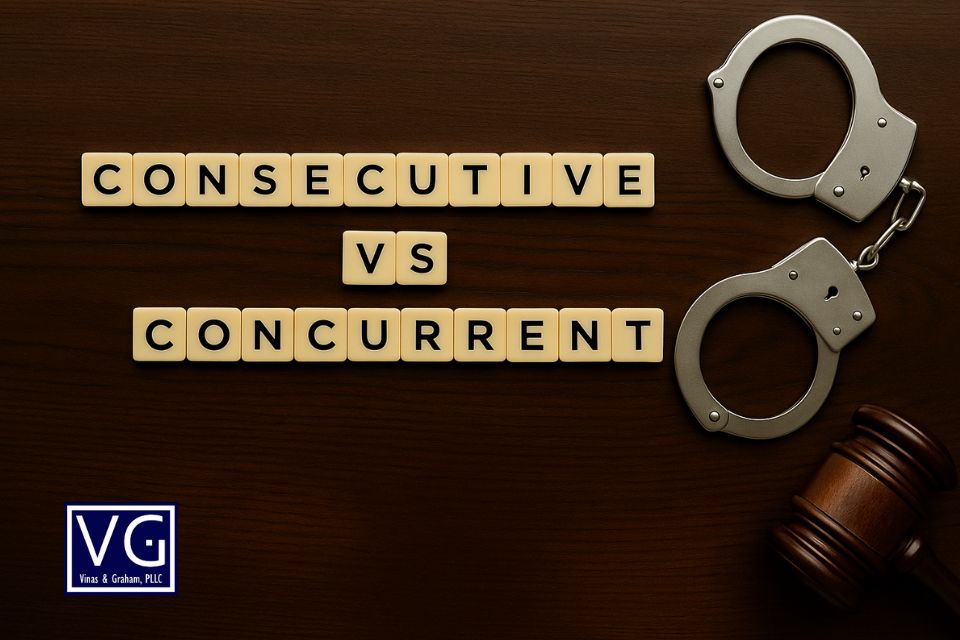The time you spend behind bars often depends on more than just the charges you face. For individuals convicted of multiple offenses, how the sentence is structured can make the difference between walking free in a few years or spending decades in prison. In Texas, the distinction between consecutive and concurrent sentences can be life-changing, especially when the court has discretion over how time is served.
At Vinas & Graham, PLLC, we know that outcomes are shaped not only by the verdict but also by what happens during sentencing. For those facing multiple charges, understanding this difference is a critical part of protecting your future.
A Fork in the Road: Two Very Different Timelines
A concurrent sentence allows a person to serve all their sentences at the same time. If someone receives five years for one conviction and five years for another, they would serve just five years total.
A consecutive sentence, on the other hand, means each sentence is served one after the other. That same individual could now face ten years behind bars instead of five.
Judges often have the authority to decide whether sentences run concurrently or consecutively. That choice can hinge on multiple factors, including the nature of the crimes, whether they were committed during the same event, and the person’s criminal history.
A strong legal defense can make a difference at this stage by highlighting mitigating factors or challenging how the charges are grouped.
When Consecutive Sentencing Comes into Play
While judges have discretion in many cases, Texas law mandates consecutive sentencing in some serious situations. These include certain sexual offenses, crimes against children, or offenses committed while out on bond or parole. Federal courts may also impose stacked sentences in cases involving weapons charges, drug trafficking, or racketeering.
Stacked sentencing refers to consecutive sentences added together for multiple convictions, served one after the other rather than at the same time.
Once stacked sentencing is on the table, the stakes rise dramatically. Instead of serving time for a single conviction, a person could face decades in prison across multiple sentences. Prosecutors may push for stacking to apply maximum pressure, especially in complex or high-profile cases.
Long-Term Impact of Stacked Time
Serving consecutive sentences can delay parole eligibility, extend incarceration far beyond what the public may expect, and affect the rest of a person’s life. Beyond time behind bars, consecutive sentencing can reduce access to rehabilitation programs, prolong family separation, and increase the emotional toll on everyone involved.
For many, the structure of a sentence is just as important as the length. Even when a conviction seems likely, the strategy used during plea negotiations and sentencing hearings can drastically alter the timeline. That’s why it is essential to address not just the charges but also the consequences of how the court handles them.
Trusted Legal Experience Can Help Reduce Time Behind Bars
A knowledgeable defense team does more than argue facts at trial. When multiple charges are involved, how a case is resolved often depends on negotiations, motions, and a deep understanding of sentencing law.
In some cases, the focus is not just on beating the charges but also on minimizing long-term consequences if a conviction occurs.
At Vinas & Graham, PLLC, attorneys Joe Vinas and Spence Graham bring over four decades of combined experience handling serious criminal cases. As former felony chief prosecutors, they understand how the state builds cases involving multiple charges and how aggressively prosecutors may seek stacked sentencing. Their in-depth knowledge of both sides of the courtroom enables them to develop targeted defense strategies that not only fight the charges but also minimize the risk of consecutive sentences that could add years—or decades—to a prison term.
If you or someone you care about is facing multiple charges, contact Vinas & Graham, PLLC to discuss how sentencing could impact the outcome. Getting the best representation early could be the key to avoiding years behind bars.



